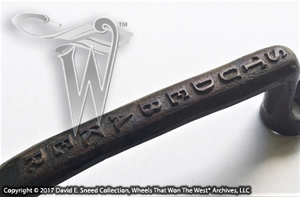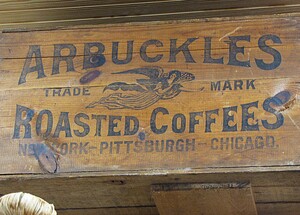Research into the background of any antique vehicle may be among the most frustrating, time-consuming, demanding, confusing, and rewarding pursuits you'll ever experience. That thought parallels a quote attributed to Thomas Edison. You know the one... "I have not failed. I've just discovered 10,000 ways that won't work." It's a statement that mirrors the difficulties in finding answers from the past while balancing perspectives of unsuccessful ventures.
Over the years, I've chased a world of unknowns related to America's first transportation industry. Without a doubt, it's a road full of potholes and opportunities for misdirection. For those who've never run headlong into the darkness of yesterday, trust me when I say there are plenty of places to stub toes and stumble around looking for light.
While these wood-wheeled wonders can appear to be the most basic of machines, they are far from it. In fact, the endless numbers of forgotten vehicle histories, identities, features, makers, jobbers, support industries, technologies, inventions, and time frames of manufacture can be dizzying. A person might wonder why anyone would worry about that history. The reason is that period-confirmed knowledge is what reinforces the overall value of these creations.
Without historical context, an antique vehicle is just another item with no value beyond that of current usability. It's a truth that's the same for any collectible, past or present. Likewise, that desire to know more helps us ensure we're passing along facts versus best guesses or wishful thinking.
Ultimately, the investigation process can be lengthy and, at times, seem void of good answers and information. The truth is that clues to the backgrounds of these wheels are literally EVERYWHERE! And that, my friends, is the problem. The pieces of these puzzles are often scattered to the four winds and covered by more than a century of neglect and forgotten knowledge. Sometimes acquiring the simplest of details can encompass years of searching. Ultimately, securing enough information to make sense of the past and put Humpty Dumpty back together again can require microscopic focus and the patience of Job!
All research begins with questions. When it comes to period wagons and stagecoaches, there are countless areas that beg for exploration. For example, all collectors (no matter the item being collected) understand that the provenance of a piece can significantly affect its value. So how much do you actually KNOW about a particular set of wheels? Could you write a 3,000 word background on a vehicle? Do you know where the vehicle has been; what has it done; who retailed it; why is it designed/adapted/repaired the way it is; what factory accessories does it have; what is the geography of where it was used; how much originality has survived; who owned it; when was it built; by whom; what were the methods used to construct it; Was the brand known by a particular phrase or tagline; what was the history in this country/world/community at the time the vehicle was built; did any period photos of it survive; is it tied to any unique community, regional, or national history; what are the unique elements of this piece - what makes it different; are there any patented parts included in the design; what do all of the surviving marks on the vehicle mean, and so forth.


Many early vehicles will be accompanied by patented features.
Again, the more details we acquire on a piece, the easier it is to talk about and be appreciated by everyone. Otherwise, there's no elements of individuality and distinctiveness to call out. In truth, though, there's always something that's noteworthy. When jumping off into the chasm of research, some of the most important things needed will be dedication, tenacity, objectiveness, patience, kindness, and indifference to perceived failures. With that said, below are some tips for getting started...
1) Determine the purpose of your research. Is it a personal curiosity, investment purpose, intrigue with regional ties, relationship to a current brand, pure historical analysis, or is the desire for provenance details related to your own stewardship or other interests? The purpose of the research will affect the direction of the study as well.
2) Determine what specifics you would like to get out of your research. Are you looking for a basic history of the vehicle, insurance-related evaluation, historic ownership records, brand overview, period photos, ties to events and people, or some other history?
3) Determine how important this is to you - it will cost time and likely money. Even if you're doing all of the leg work, there will be a cost. Like it or not, we do tend to get what we pay for. Even then, there are no guarantees as to what or how much material can be found.
4) If - after all this - you still want to proceed, then begin with what you know - AND BACKTRACK! Explore leads from what is known. If very little is known, you might consider hiring a qualified vehicle historian to help. This is a common practice with family genealogies. It's no different with antique vehicles.
6) Don't be afraid of inconsistencies. Thoseinsights can harbor valuable information.
7) Be objective and also specific with questions related to your vehicle. What kinds of questions? As mentioned in the introduction, ask yourself what you would want to know if you were going to write a lengthy essay. You may not get confirmed answers on everything but you're likely to fill in some important gaps.
8) Be polite when reaching out to others. We live in a world where impatience and rudeness seem to be the norm. I don't know anyone who responds well to offensive, impatient, or arrogant behavior but courtesy, respect, and thoughtfulness can open all kinds of doors. Also recognize that the time others spend helping with the research has value. Be considerate of that point.
9) Be persistent, purposed, and prepared. You never know where the next clue or tidbit of information may come from. Keeping a camera, paper, and pen with you - as well as other things like a lupe/magnifying glass, flashlight, tape measure, and even a bottle of distilled water can help you uncover and record information in remote locations.
10) Be open-minded and avoid preconceptions.
11) Likewise, be careful about relying on unsupported assertions as fact. Social media is full of unproven guesses and misdirection. I recently saw a post where a freshly painted wagon reach plate was shown as a close-up shot. No other part of the wagon was visible. The accompanying comment/questions with the post can be paraphrased as... This was on my wagon. What is the brand and when was it built? Both of these are good questions and there was no shortage of folks attempting to give helpful answers. There's just one (Huge) problem. It's unwise to look at one part and try to identify a wagon. Why? Because the part may have been replaced or could be applied to multiple brands. In this case, the reach plate was indeed used for multiple brands. For similar reasons, the date of a vehicle should never be predicted by using one element. It's a practice that can easily result in misguided information. Because these vehicles evolved over time, we have to look at the collective whole to make sense of the brand and timeframe of manufacture.
12) Keep good records. DOCUMENT, DOCUMENT, DOCUMENT.
13) BE ORGANIZED and cross reference details you uncover. All of the puzzle pieces may be easy to remember, initially. However, without thorough documentation, things have a way of getting fuzzy.
14) Be vigilant and stay focused. There are a thousand rabbit holes and meandering roads leading to and from your subject.Tackle each one separately.
15) Be thorough. You're looking for needles in haystacks. Any oversight could miss an important clue being harbored by your treasure. Some things may not even register at first. For example, our Overland stage has significant marks on the rear axle. Initially, we could only speculate as to what created the marks. After years of research, we uncovered a story of this very stage working the Lemhi Pass in the Rocky Mountains. The article included a photo of the coach as well as a harrowing tale of tying a tree to the axle to slow the steep descent, only to have the rope break and the coach run away, nearly careening over the edge of the high, narrow trail! What an incredible find! Only through a diligent search process was this discovery possible.
17) Glean the resources. Occasionally circle back through previously searched materials, areas, people, etc, making sure you haven't missed something. Sometimes, a second interview with the same person or another look at a photo or book can reveal details overlooked the first time.
18) Network, network, network. Recognize others may have knowledge about what you're looking for - due to their experience(s).

A rare, Studebaker Mountain wagon we came across during our research travels.
Next week, I'm hoping to cover another unique tribute to the wheels of the West. If you're new to these reads, I try to post at least one blog per week. The stories are usually posted by Tuesday or Wednesday. If you have a topic you'd like to see us cover, please drop us a line. We'd enjoy hearing from you. Good luck in your pursuits!!
Ps. 20:7

















